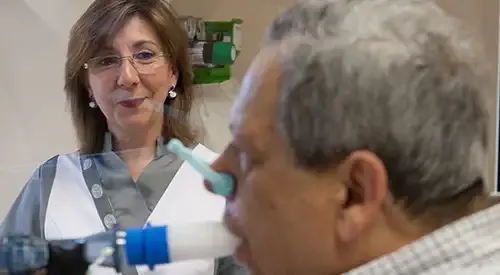Idiopathic pulmonary fibrosis
"Currently there is great interest in research into new drugs that achieve clinical and prognostic improvement in patients affected by this disease".
DR. ARANTZA CAMPO EZQUIBELA
SPECIALIST. PNEUMOLOGY DEPARTMENT

Idiopathic pulmonary fibrosis is a chronic disease that affects both lungs in a diffuse way.
It is characterized by progressive scarring (fibrosis) that causes the lung to lose flexibility, and deteriorate its function over time.
It is included within the interstitial lung diseases. Its diagnosis requires proving that there is a pattern of alteration of the lung typical in radiological tests or lung biopsy called usual interstitial pneumonia. It is also important to rule out the existence of other causes that could have originated it as rheumatic diseases (connective tissue diseases), exposure to certain environmental agents, some drugs, etc.
Diffuse interstitial lung disease (DIPD) comprises a broader group of interstitial diseases, which require a differentiated diagnosis and treatment.

What are the symptoms of idiopathic pulmonary fibrosis?
The symptoms of idiopathic pulmonary fibrosis can be very variable, from not producing any symptoms to producing exhaustion with any effort.
The most frequent symptoms are the feeling of shortness of breath with effort and cough, which progresses over years or months, and in advanced stages, respiratory failure with the need for oxygen therapy.
The most common symptoms are:
- Feeling of lack of air.
- Coughing.
- In advanced stages: respiratory insufficiency.
Do you have any of these symptoms?
You may have idiopathic pulmonary fibrosis
What are the causes of pulmonary fibrosis?
The cause is unknown, but there are some potential risks for developing this disease, including the following:
- Tobacco: There appears to be a direct relationship between the number of cigarettes smoked per day for several years.
- Chronic aspiration: secondary to gastroesophageal reflux.
- Genetic and family factors: there is a greater frequency of the disease in some families. In recent years, certain genes have been discovered that may predispose to the development of the disease.
How is pulmonary fibrosis diagnosed?

The diagnosis of pulmonary fibrosis is made through appropriate clinical questioning, chest radiography and high resolution computed tomography (CT scan).
A lung tissue biopsy may be required when the alterations seen on the CT scan do not allow a definitive diagnosis of the disease. This biopsy can be performed by bronchoscopy (transbronchial biopsy or cryobiopsy) or surgery (videothoracoscopy).
Bronchoalveolar lavage performed through a bronchoscopy helps to rule out other diseases but it is not very specific to make the diagnosis of pulmonary fibrosis and is only performed on some occasions.
In pulmonary function tests there are some characteristics that suggest a pulmonary restriction (decrease in the size of the lungs) and alterations in the capacity of the lung to exchange gases (oxygen and carbon dioxide).
The 6-minute walk test allows us to assess the impact of the disease on exercise capacity. These measurements allow us to assess the severity of the disease, its evolution over time and response to treatment.
In patients with interstitial involvement or pulmonary fibrosis and a family history of pulmonary fibrosis, a genetic study can be performed to determine whether there are genetic alterations associated with this disease.
How is idiopathic pulmonary fibrosis treated?
Conventional treatment for idiopathic pulmonary fibrosis consists of using anti-fibrotic drugs, which slow the progression of the disease and may prolong survival. Two drugs are currently approved for treatment in Europe and Spain and are taken orally: Pirfenidone (Esbriet®) and Nintedanib (Ofev®). The use of these drugs requires that the diagnosis of the disease be well established and there are no contraindications.
Oxygen may be necessary in patients who have low blood levels.
Pulmonary rehabilitation may help maintain the ability to exercise without breathing difficulty.
Some patients may need a lung transplant. This procedure is usually considered for patients under 65 years of age whose disease has not responded well to medical treatments.
Where do we treat it?
IN NAVARRE AND MADRID
The Department of Pneumology
of the Clínica Universidad de Navarra
Specializing in smoking and tobacco-related diseases, the Department has over 15 years of experience in smoking cessation and lung cancer early detection programs.
The department's specialists have received training at leading centers around the world, including centers in the United States, and have extensive experience in the diagnosis and treatment of all respiratory diseases, both common and rare.
Diseases we treat
|

Why at the Clínica?
- Leading clinical assistance with great work in research and teaching.
- Specialized nursing team.
- We work together with the Sleep Unit and the Lung Cancer Area.








